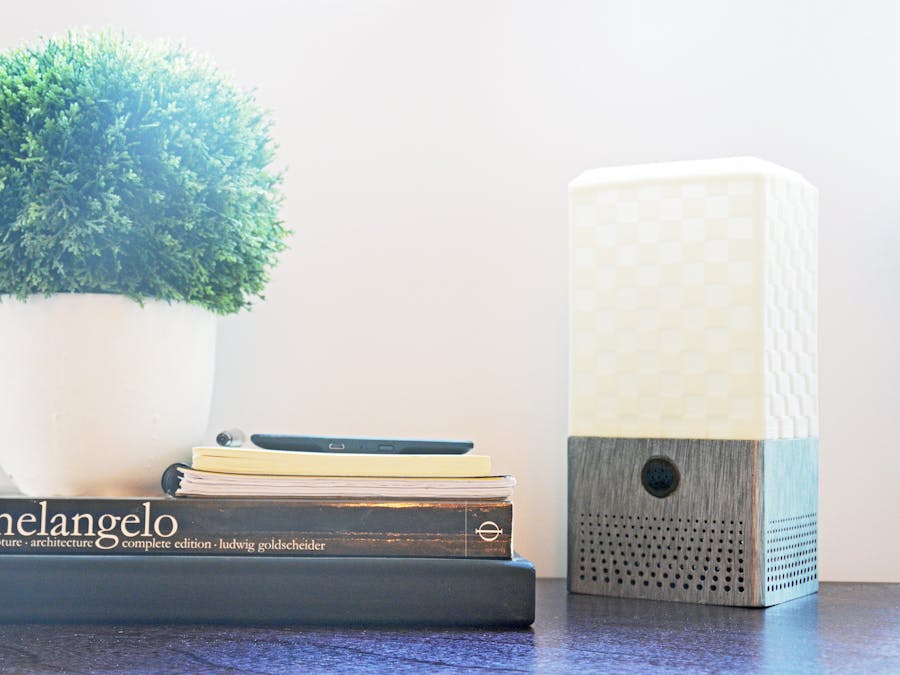This build was intended to be a combination of a smart speaker (run by Google Assistant) and a smart lamp (Philips Hue light bulb). However, this was quite an ambitious build so the design work could use some refining and for that reason I have included the Fusion 360 design files in case you want to make modifications, but please excuse the amateur design skills that will be clearly evident. This can be completed in a number of variations, though I am going to document just my steps but feel free to improvise wherever you like. This is a combination of 3D printed parts (enclosure mostly) and an assembly of various components, but I also opted to try my hand at Hydro-dipping the base for a cool finish - this is strictly optional and I will try to call it out in the materials list and instructions in case you want to skip this. No specialized tools are required and a 3D printer is not required - you can utilize a print service such as 3DHubs.com to obtain the 3D printed parts from a local printer.
Materials:
- Hydro-dip kit (optional)
- Sound Card for Raspberry Pi (probably optional)
Tools:
- Orbital Sander (optional)
***Links provided are affiliate links if used to purchase something may provide Adylinn Studio a small commission.
RecommendationsI’d recommend taking some time to look at the project and see if you want to change anything ahead of time and plan around those changes. I specifically would look at some of the design issues with this particular build and suggest designing a new base with the speaker facing forward instead of downward. Installing the software onto the Raspberry Pi is not advanced but it does require some level of technical expertise. I would suggest going with Amazon Alexa since that has been out for some time and most likely has the best beginner instructions available.
Installing Smart AssistantIf you intend to install Google Assistant - follow these instructions. If you intend to install Amazon Alexa - follow these instructions.
3D Printed PartsIf you are sourcing your 3D printed parts, I’d suggest a local printer on 3D Hubs so you can pick up your printed pieces without having to risk shipping. Be sure to communicate the below settings when placing your order:
Base and Back (decent surface quality to limit amount of sanding needed)
- Filament choice not really important
- 0.2mm layer height
- 15-20% infill
- No Support
- Brim optional
Shade (decent surface quality to limit amount of sanding needed)
- Translucent light filament (eSun Natural HIPS is a good choice)
- 0.1 or 0.2mm layer height
- 10% infill
- No Support
- Brim optional
Light Fixture
- Filament choice not really important
- 0.2mm layer height or higher
- 10% infill
- No Support
- Brim optional
- Remove any brim if necessary.
- Sand shade to the desired smoothness. Start with 220 or 320 grit and move up until you have a nicely smooth part without visible print lines.
- Wipe the sanded parts with a lightly damp cloth or paper towel.
- Once the parts are dry, evenly apply clear coat.
Follow hydro-dipping instructions to add a graphic to your pieces.
- This involves filling up a container of water between 80-85 degrees Fahrenheit.
- Cutting film to necessary dimensions and apply tape to the border.
- Placing film into water for 60 seconds while removing any bubbles or creases.
- Spray film lightly with activator.
- Dipping part at 30-45 degree angle to apply graphic (submerge completely)
- Rinsing under water for 3-5 minutes to remove residue/coating.
- Remove any brim if necessary.
- Sand shade to the desired smoothness. Start with 120 and move up to 320 grit and continue sanding until you have a nicely smooth part without visible print lines.
- Use putty to fill any remaining defects.
- Sand down any spots where putty was applied until surface is smooth.
- Wipe the sanded parts with a lightly damp cloth or paper towel.
- Evenly apply primer to the parts.
- Once primer has dried, lightly sand primer and wipe down.
- At this point you can paint the parts and move to clear coating OR use base paint coat prior to hydro-dipping your part.
- Once the parts are dry, evenly apply clear coat.
- Remove any brim if necessary.
- Sand shade to the desired smoothness. Start with 220 or 320 grit and move up until you have a nicely smooth part without visible print lines.
- Wipe the sanded parts with a lightly damp cloth or paper towel.
- Once the parts are dry, evenly apply clear coat.
Thanks for checking out the DIY Smart Assistant Speaker and Lamp build! If you enjoyed it, I post monthly builds using 3D printing on my website, https://www.adylinn.com/builds/.













Comments